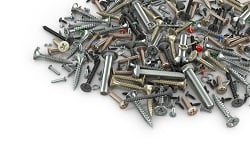
In the beginning, there were nails. 3400 BC is the earliest known use of them, in Ancient Egypt. It took 3337 years for screws to become the “next wave” in fasteners, found in 3rd century BC Greece. As you can tell, the innovations in fasteners picked up speed in the last few hundred years. Prior to the 1800s, screws were made by hand specifically for the purpose they were needed for. Then they began to produce them in forms, creating the ability to standardize and reproduce them with ease. Now, there are not only thousands of fastener options, but a wide range of finishes as well, each suited to a specific task. Here is a quick guide to the finishes you’ll see in the market today.
Bright: A bright finish indicates there is no coating on the fastener. These uncoated steel fasteners are susceptible to rust and corrosion, and not to be used for exterior work.
Galvanized: This means the nail is covered with a zinc coating as a protective barrier to avoid rust and corrosion. There are several methods of applying the coating.
Electro-galvanized: This is another term for 'zinc electroplating'. That means the steel is immersed in an aqueous bath, and electricity is used to move electrons from the anode to the cathode, which induces the zinc anodes to be "oxidized" and dissolve as zinc ions in the aqueous solution, then transported as ions through the solution, and "reduced" as metal onto the work (the cathode). This creates a thin, shiny protective coating. These are used in most residential construction, but are not suitable for use with acidic materials, such as redwood, cedar, or treated lumber, etc.
Hot-Dipped: In hot-dip galvanizing, the fastener is immersed in molten zinc. As it is withdrawn, the zinc cools and forms a coating of zinc. Hot-dipped can be up to 10X thicker than electro-galvanized, and tend to have a longer life, especially when exposed to corrosive elements like salt water. The finish tends to be dull, grainy and crystallized.
Coppered/ Copper Clad: This refers to copper coating on staples, generally. It combines the power of steel with the conductivity and corrosion resistance of copper. Copper also increases the tensile strength of the staples, making them stronger even when being pulled apart.
FasCoat®: This is a proprietary finish designed by the BECK Fastener Group®. It is specifically used in applications needing higher corrosion protection than Hot-Dipped galvanization where the environment is exposed to corrosive elements, like salt. This is ideal for exterior decking applications except in high salinity enviroments. The finish withstands more than 2,000 hours in the salt spray test.
When choosing fasteners for your next job, be mindful to choose the finish that is best suited to the task at hand to keep your construction lasting longer. FASCO America® offers a wide range of staples, collated nails, and SCRAIL® fasteners in a variety of finishes. No matter what the job, we have a fastener that fits. Download the Diamond Coating Brochure by clicking the button below.
.svg.png)

